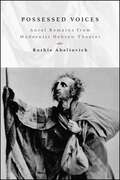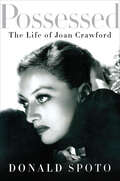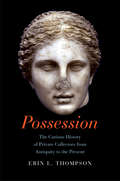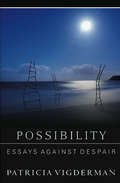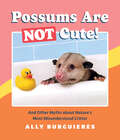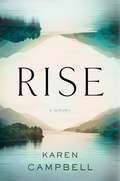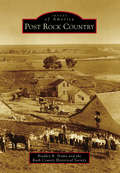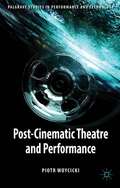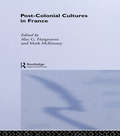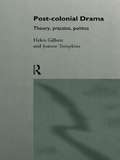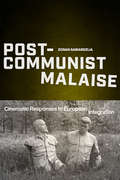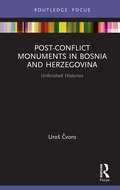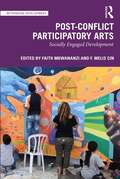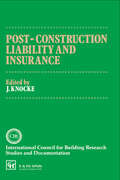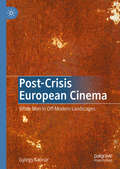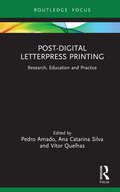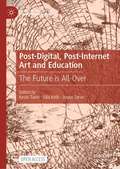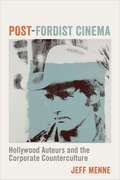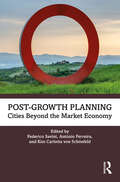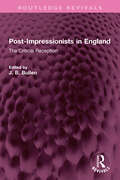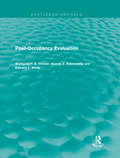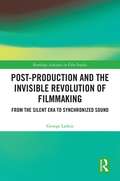- Table View
- List View
Positively Crochet!: 50 Fashionable Projects and Inspirational Tips
by Mary Jane HallPositively Crochetlives up to its name with plenty of crochet projects and powerful messages for positive living. This playful, project-focused guide concentrates on the patterns and stitches used to design the 50+ fashionable projects in this book, which include scarves, shrugs, sweaters, hats, purses and belts. In addition to trendy garments and accessories, you will discover pairings of design tips with inspirational insight, useful for improving crochet skills and making the most of every situation life delivers.
Possessed Voices: Aural Remains from Modernist Hebrew Theater (SUNY series in Contemporary Jewish Literature and Culture)
by Ruthie AbeliovichFinalist for the 2020 Jordan Schnitzer Book Award in the category of Jews and the Arts: Music, Performance, and Visual presented by the Association for Jewish StudiesPossessed Voices tells the intriguing story of a largely unknown collection of audio recordings, which preserve performances of modernist interwar Hebrew plays. Ruthie Abeliovich focuses on four recordings: a 1931 recording of The Eternal Jew (1919/1923), a 1965 recording of The Dybbuk (1922), a 1961 radio play of The Golem (1925), and a 1952 radio play of Yaakov and Rachel (1928). Abeliovich traces the spoken language of modernist Hebrew theater as grounded in multiple modalities of expressive practices, including spoken Hebrew, Jewish liturgical sensibilities supplemented by Yiddish intonation and other vernacular accents, and in relation to prevalent theatrical forms. The book shows how these recorded performances provided Jewish immigrants from Europe with a venue for lamenting the decline of their home communities and for connecting their memories to the present. Analyzing sonic material against the backdrop of its artistic, cultural, and ideological contexts, Abeliovich develops a critical framework for the study of sound as a discipline in its own right in theater scholarship.
Possessed: The Life of Joan Crawford
by Donald SpotoJoan Crawford was one of the most incandescent film stars of all time, yet she was also one of the most misunderstood. In this brilliantlyresearched, thoughtful, and intimate biography, bestselling author Donald Spoto goes beyond the popular caricature—the abusive, unstable mother portrayed in her adopted daughter Christina Crawford’s memoir, Mommie Dearest—to give us a three-dimensional portrait of a very human woman, her dazzling career, and her extraordinarily dramatic life and times.Based on new archival information and exclusive interviews, and written with Spoto’s keen eye for detail, Possessed offers a fascinating portrait of a courageous, highly sexed, and ambitious womanwhose strength and drive made her a forerunner in the fledgling film business. From her hardscrabble childhood in Texas to her early days as a dancer in post–World War I New York to her rise to stardom,Spoto traces Crawford’s fifty years of memorable performances in classics like Rain, The Women, Mildred Pierce, and Sudden Fear, which are as startling and vivid today as when they were filmed.In Possessed, Spoto goes behind the myths to examine the rise and fall of the studio system; Crawford’s four marriages; her passionate thirty year, on-and-off-again affair with Clark Gable; her friendships and rivalries with other stars; her powerful desire to become a mother; the truth behind the scathing stories in her daughter Christina’s memoir; and her final years as a widow battling cancer. Spoto explores Crawford’s achievements as an actress, her work with Hollywood’s great directors (Frank Borzage, George Cukor, Otto Preminger) and actors (Henry Fonda, James Stewart, Spencer Tracy, John Barrymore), and later, her role as a highly effective executive on the board of directors of Pepsi-Cola.Illuminating and entertaining, Possessed is the definitive biography of this remarkable woman and true legend of film.
Possession: The Curious History of Private Collectors from Antiquity to the Present
by Erin ThompsonWhether it's the discovery of $1. 6 billion in Nazi-looted art or the news that Syrian rebels are looting UNESCO archaeological sites to buy arms, art crime commands headlines. Erin Thompson, America's only professor of art crime, explores the dark history of looting, smuggling, and forgery that lies at the heart of many private art collections and many of the world's most renowned museums. Enlivened by fascinating personalities and scandalous events, Possession shows how collecting antiquities has been a way of creating identity, informed by a desire to annex the past while providing an illicit thrill along the way. Thompson's accounts of history's most infamous collectors--from the Roman Emperor Tiberius, who stole a life-sized nude Greek statue for his bedroom, to Queen Christina of Sweden, who habitually pilfered small antiquities from her fellow aristocrats, to Sir William Hamilton, who forced his mistress to enact poses from his collection of Greek vases--are as mesmerizing as they are revealing.
Possibility: Essays Against Despair
by Patricia Vigderman"Reading Patricia Vigderman is like attending an ideal dinner party, where everyone has read your favorite books. Her essays wind particular passages of Proust, or George Eliot, or W.G. Sebald around personal moments; David Foster Wallace's story 'The Depressed Person' is threaded throughout an essay about her own relationship with a loved one's serious depression. Vigderman's responses are fresh and original and her sounding of our collective literary treasures are likely to send you back to read them again, now overlaid with her embroidery."-Mona SimpsonIn this accessible collection of essays, Patricia Vigderman attempts to translate some of life's disordered events into the orderly happiness of art. She encounters manatees, children, and snakes; with Henry Adams, Marcel Proust, and W.G. Sebald; with Texas landscape, Vertigo, and Johannes Vermeer. Adams, in Japan after his wife's death, found in the elaborate ritual of the tea ceremony and in the discomforts of a rural inn, occasions for the wit to face down grief. His letters to friends coax laughter from strangeness and loss. Like Adams, Vigderman has a stylist's passion for revelatory detail, and for the pleasure of immersion in a world. Smart, generous, and probing, her discoveries play with direct experience, exploring the interaction of life and art as "magic you can walk in and out of."Patricia Vigderman's work has appeared in The Nation, The New York Times, Georgia Review, Raritan, and others. She was a Literature Fellow at the Liguria Center for the Arts and Humanities in Italy and teaches at Kenyon College.
Possums Are Not Cute!: And Other Myths about Nature's Most Misunderstood Critter
by Ally BurguieresPossums may steal your garbage…but with this book, they&’ll also steal your heart!Possums are more than the ugly-cute icons of the internet. These so-called trash animals and pointy kitties are not only relatable avatars for anxious but resilient people everywhere, but nature&’s secret clean-up crew. Organized around common myths that have given possums a bad reputation, this fun and offbeat book reveals the truth about possums through dozens of adorable photos, informative illustrations, and fascinating facts. Did you know that… • Possums protect people and pets from disease! A single possum can eat up to 4,000 ticks per week! • Possums excel at interspecies friendships, often sleeping in other animals&’ dens. • Possums are shy creatures: when they &“play dead,&” they are actually fainting from anxiety! Written by wildlife rehabber and possum advocate Ally Burguieres, known for her popular Instagram account @ItsMeSesame, this accessible and giftable guide explains why possums deserve our admiration and offers tips on how we can protect and advocate for these magical marsupials.
Post Cards from Space: In September
by Lawrence Wright"A magnificent book [from] one of our finest nonfiction writers. . . . In his minute-by-minute account of the talks Wright intersperses a concise history of Egyptian-Israeli relations dating from the story of Exodus. Even more important is Wright's understanding that Sadat, Begin and Carter were not just political leaders, but exemplars of the Holy Land's three internecine religious traditions
Post Rock Country (Images of America)
by Rush County Historical Society Bradley R. PenkaRush County, at the south end of Post Rock Country, was organized on December 5, 1874, and named in honor of Capt. Alexander Rush, Company H, of the 2nd Kansas Colored Infantry. The first settlers arrived in 1869 and established homesteads along Walnut Creek near the Fort Hays-Fort Dodge Trail. With few trees on the vast, dry prairie, settlers searched for alternative building materials. Post Rock, a unique limestone bed that sat within inches of the surface, was so well used and became such a curiosity that it gave rise to the Post Rock Museum in 1963.
Post-Cinematic Theatre and Performance
by Piotr WoycickiA cinema without cameras, without actors, without screen frames and without narratives almost seems like an antithetical impossibility of what is usually expected from a cinematic spectacle. This book defines an emergent field of post-cinematic theatre and performance, challenging our assumptions and expectations about theatre and film.
Post-Colonial Cultures in France
by Alec Hargreaves Mark McKinneyEthnic minorities, principally from Africa, Asia, the Caribbean and the surviving remnants of France's overseas empire, are increasingly visible in contemporary France. Post-Colonial Cultures in France edited by Alec Hargreaves and Mark McKinney is the first wide-ranging survey in English of the vibrant cultural practices now being forged by France's post-colonial minorities. The contributions in Post-Colonial Cultures in France cover both the ethnic diversity of minority groups and a variety of cultural forms ranging from literature and music to film and television. Using a diversity of critical and theoretical approaches from the disciplines of cultural studies, literary studies, migration studies, anthropology and history, Post-Colonial Cultures in France explores the globalization of cultures and international migration.
Post-Colonial Drama: Theory, Practice, Politics
by Helen Gilbert Joanne TompkinsPost-Colonial Drama is the first full-length study to address the ways in which performance has been instrumental in resisting the continuing effects of imperialism. It brings to bear the latest theoretical approaches from post-colonial and performance studies to a range of plays from Australia, Africa, Canada, New Zealand, the Caribbean and other former colonial regions. Some of the major topics discussed in Post-Colonial Drama include: * the interactions of post-colonial and performance theories * the post-colonial re-stagings of language and history * the specific enactments of ritual and carnival * the theatrical citations of the post-colonial body Post-Colonial Drama combines a rich intersection of theoretical approaches with close attention to a wide range of performance texts.
Post-Communist Malaise: Cinematic Responses to European Integration (Media Matters)
by Zoran SamardzijaThe collapse of communism in the Soviet Union and Eastern Europe was supposed to bring about the “end of history” with capitalism and liberal democracy achieving decisive victories. Europe would now integrate and reconcile with its past. However, the aftershocks of the financial crisis of 2008—the rise in right-wing populism, austerity politics, and mass migration—have shown that the ideological divisions which haunted Europe in the twentieth century still remain. It is within this context that Post-Communist Malaise revives discourses of political modernism and revisits debates from Marxism and seventies film theory. Analyzing work of Theo Angelopoulos, Vera Chytilová, Srdjan Dragojevic, Jean-Luc Godard, Miklós Jancsó, Emir Kusturica, Dušan Makavejev, Cristi Puiu, Jan Švankmajer, Andrei Tarkovsky, and Béla Tarr, the book focuses on how select cinemas from Eastern Europe and the Balkans critique the neoliberal integration of Europe whose failures fuel the rise of nationalism and right-wing politics. By politicizing art cinema from the regions, Post-Communist Malaise asks fundamental questions about film, aesthetics, and ideology. It argues for the utopian potential of the materiality of cinematic time to imagine a new political and cultural organization for Europe.
Post-Conflict Monuments in Bosnia and Herzegovina: Unfinished Histories (Routledge Focus on Art History and Visual Studies)
by Uroš ČvoroAt a time of dramatic struggles over monuments around the world, this book examines monuments that have been erected in post-conflict Bosnia and Herzegovina (BiH) since 1996. Examining the historical precedents for the high rate of monumentbuilding, and its links to ongoing political instability and national animosity, this book identifies the culture of remembrance in BiH as symptomatic of a broader shift: a monumentalisation and privatisation of history. It provides an argument for how to account for the politics of contemporary nation-state formation, control of space, trauma and revisions of history in a region that has been subject to prolonged instability and crisis. This book will be of interest to scholars in contemporary art, museum studies, war and conflict studies, and European studies.
Post-Conflict Participatory Arts: Socially Engaged Development (Rethinking Development)
by Faith MkwananziThis book investigates the power of art to enhance human development and to initiate positive social change for individuals and societies recovering from conflict. Interventions aimed at reinforcing social justice and bringing communities together after conflict are often accused of being top-down, or failing to consider all groups and contexts within a society. The use of participatory arts can help to address these challenges by fostering community engagement, social cohesion, influencing public policy, and ultimately, advancing social justice. Arts-based methods can be particularly effective at reaching youth communities, providing voice and political agency to young people who are often not given a platform. Situated at the intersection of participatory arts, social and epistemic justice, this book brings together case studies from across the world to reflect on best practice for the use of bottom-up, participatory, co-produced, and co-designed arts processes in conflict settings. This book provides an important guide to the role that arts can play in addressing epistemic injustice and contributing to social justice and human development. As such, it will be of interest to international development and arts practitioners, policy makers, and to students and researchers across participatory arts, youth studies, international development, social justice, and peace and conflict studies.
Post-Conflict Performance, Film and Visual Arts
by Des O'Rawe Mark PhelanDrawing on a range of cities and conflicts from Europe, Africa and the Middle East, the collection explores the post-conflict condition as it is lived and expressed in modern cities such as Berlin, Belfast, Bilbao, Beirut, Derry, Skopje, Sarajevo, Tunis, Johannesburg and Harare. Post-Conflict Performance, Film and Visual Arts: Cities of Memory investigates how the memory of conflict can be inscribed in historical monuments, human bodies and hermeneutic acts of mapping, traversing, representing, and performing the city. Several essays explore the relations between memory, history and urban space; where memory is located and how it is narrated, as well as various aspects of embodied memory; testimonial memory; traumatic memory; counter-memory; false memory; post-memory. Other essays examine the representations of post-war cities and how cultural imaginations relate to the politics of reconstruction in places devastated by protracted urban warfare. Post-Conflict Performance, Film and Visual Arts: Cities of Memory offers a comparative survey of the complex and often controversial encounters between public art, political memory and commemoration in divided societies, as well as offering insights into the political and ethical difficulties of balancing the dynamics of forgetting and remembering.
Post-Construction Liability and Insurance
by J. KnockeWith the single European market and the growing internationalisation of the work of architects, engineers and contractors it is important for professionals to be aware of the liability provisions of legal systems around the world. An essential reference for lawyers and insurance companies, especially in construction law and insurance, this is required reading for construction professionals involved in international work.
Post-Crisis European Cinema: White Men in Off-Modern Landscapes
by György KalmárThis book explores the cinematic representations of the pervasive socio-cultural change that the 21st century brought to Europe and the world. Discussing films such as I, Daniel Blake, Cold War and Jupiter’s Moon, it puts distinctively “post-crisis”, gendered representations in a complex, theoretically informed and socially committed interdisciplinary perspective that maps the newly emerging formations of masculinity at a time of rapid socio-economic transition. Kalmar argues that the series of crises that started with the 9/11 terrorist attacks changed some of our fundamental expectations about history, debunked many of our grand narratives, and thus changed the cultural logic of our (thoroughly globalized) civilization. The book focuses on the ways cinema reflects, interprets and shapes a rapidly changing world: the hot issues of the times, the new formations of identity, and the shifts in cinematic representation. This is an interdisciplinary research that is equally interested in what new the 21st century brought about, most specifically to Europe and to its white men, as in film and its responses to these socio-cultural changes.
Post-Digital Letterpress Printing: Research, Education and Practice (Routledge Focus on Art History and Visual Studies)
by Pedro Amado, Ana Catarina Silva and Vítor QuelhasThis book presents an overview of the convergence of traditional letterpress with contemporary digital design and fabrication practices. Reflecting on the role of letterpress within the emergent hybrid post-digital design process, contributors present historical and contemporary analysis, grounded in case studies and current practice. The main themes covered include the research on letterpress as a technology and medium; a reflection on the contribution of letterpress to arts and design education; and current artistic and communication design practice merging past, present and future digital fabrication processes. This will be of interest to scholars working in graphic design, communication design, book design, typography, typeface design, design history, printing, and production technologies.
Post-Digital, Post-Internet Art and Education: The Future is All-Over (Palgrave Studies in Educational Futures)
by Kevin Tavin Gila Kolb Juuso TervoThis open access edited volume provides theoretical, practical, and historical perspectives on art and education in a post-digital, post-internet era. Recently, these terms have been attached to artworks, artists, exhibitions, and educational practices that deal with the relationships between online and offline, digital and physical, and material and immaterial. By taking the current socio-technological conditions of the post-digital and the post-internet seriously, contributors challenge fixed narratives and field-specific ownership of these terms, as well as explore their potential and possible shortcomings when discussing art and education. Chapters also recognize historical forebears of digital art and education while critically assessing art, media, and other realms of engagement. This book encourages readers to explore what kind of educational futures might a post-digital, post-internet era engender.
Post-Fordist Cinema: Hollywood Auteurs and the Corporate Counterculture (Film and Culture Series)
by Jeff MenneThe New Hollywood boom of the late 1960s and 1970s is celebrated as a time when maverick directors bucked the system. Against the backdrop of counterculture sensibilities and the prominence of auteur theory, New Hollywood directors such as Robert Altman and Francis Ford Coppola seemed to embody creative individualism. In Post-Fordist Cinema, Jeff Menne rewrites the history of this period, arguing that auteur theory served to reconcile directors to Hollywood’s corporate project.Menne traces the surprising affinities between auteur theory and management gurus such as Peter Drucker, who envisioned a more open and flexible corporate style. In founding production companies, New Hollywood filmmakers took part in the creation of new corporate models that emphasized entrepreneurial creativity. For firms such as Kirk Douglas’s Bryna Productions, Altman’s Lion’s Gate Films, the Zanuck-Brown Company, and BBS Productions, the counterculture ethos limbered up the studio system’s sclerotic production process—with striking parallels to how management theory conceived of the role of the individual within the firm. Menne offers insightful readings of how films such as Lonely Are the Brave, Brewster McCloud, Jaws, and The King of Marvin Gardens narrate the conditions in which they were created, depicting shifting notions of work and corporate structure. While auteur theory allowed directors to cast themselves as independent creators, Menne argues that its most consequential impact came as a management doctrine. An ambitious rethinking of New Hollywood, Post-Fordist Cinema sheds new light on the cultural myth of the great director and the birth of the “creative economy.”
Post-Growth Planning: Cities Beyond the Market Economy
by Federico SaviniThis book draws on a wide range of conceptual and empirical materials to identify and examine planning and policy approaches that move beyond the imperative of perpetual economic growth. It sketches out a path towards planning theories and practices that can break the cyclical process of urban expansion, crises, and recovery that negatively affect ecosystems and human lives. To reduce the dramatic social and environmental impact of urbanization, this book offers both a critique of growth-led urban development and a prefiguration of ecologically regenerative and socially just ways of organizing cities and regions. It uncovers emerging possibilities for post-growth planning in the fields of collective housing, mobility, urban commoning, ecological land-use, urban–rural symbiosis, and alternative planning worldviews. It provides a toolkit of concepts and real-life examples for urban scholars, urbanists, activists, architects, and designers seeking to make cities prosper within planetary boundaries. This book speaks to both experts and beginners in post-growth thinking. It concludes with a manifesto and glossary of key terms for urban scholars, students, and practitioners.
Post-Impressionists in England: The Critical Reception (Routledge Revivals)
by J. B. BullenFirst Published in 1988, Post-impressionists in England documents the response of English taste to modern French art from the first Post-Impressionist Exhibition in 1910 to the outbreak of the First World War. The notion of ‘Post-Impressionism’, unlike its earlier counterpart, Impressionism, was an exclusively English contribution to art history. Originally used to denote the work of Cezanne, Van Gogh, Gauguin, Matisse and the Fauve painters, it rapidly assimilated Futurism, Cubism and recent English work like Vorticism. By focusing on one aspect of an important and complex period in British cultural history, J.B. Bullen illuminates not only aesthetic questions but also the way in which those aesthetic issues were determined and conditioned by social and political concerns.Changes in English attitudes to art in this period were so rapid and were modified with such speed that the author has taken a strictly chronological approach to the subject. He sets out clearly the month-by-month developments in English attitudes and traces in detail the debates about modernism in England. To make matters clearer the book is divided into three major parts, each complementary to the others. The introduction surveys the period as a whole and places attitudes to art in the general context of the culture of the time. In the second part the extracts provide selected, concrete and particular examples of the huge range of material upon which the findings of the introduction are based; the writers represented include Roger Fry, Bernard Berenson, Desmond McCarthy, John singer Sargent, Walter Sickert, Clive Bell, Virginia Woolf and Wyndham Lewis. In the third part a chronology sets out in tabular form month-by-month events- exhibitions and major publications- as they occurred in Britain and in France. This is a must read for scholars and researchers of British cultural history and art history.
Post-Occupancy Evaluation (Routledge Revivals)
by Edward White Wolfgang F. Preiser Harvey RabinowitzPost-occupancy evaluation, focusing on building’s occupants and their needs, provides insight into the consequences of past design decisions and forms a sound basis for creating better buildings in the future. This book, first published in 1988, includes a review of the evolution of the field, a conceptual frame-work for POE, and pragmatic information on planning, conducting, and reporting POEs. Post-Occupancy Evaluation categorizes the approaches to building evaluation by describing the three levels of POE effort – indicative, investigative, and diagnostic, each differing in terms of time, resources, and personnel needed. In its scope Post-Occupancy Evaluation is both comprehensive and specific; professionals in the design and planning disciplines will find it an invaluable resource for understanding the theory behind POE’s and the procedures needed to put the theory into practice.
Post-Petroleum Design
by George ElvinDespite the growing demand for design strategies to reduce our petroleum use, no one has yet brought together the lessons of the world’s leading post-petroleum designers into a single resource. Post-Petroleum Design brings them together for the first time. Readers will be introduced to the most current, innovative, plastic-and petroleum-free products and projects in industrial design, architecture, transportation, electronics, apparel and more. Post-Petroleum Design explores firsthand the client and consumer motivations behind the demand, and shares the case studies, principles, best practices, risks and opportunities of the world’s leading post-petroleum design experts who are already meeting that demand. It introduces 40 inspiring individuals from across the globe; people like Eben Bayer, the American innovator whose company, Ecovative, is growing houses from mushrooms; Mohammed Bah Abba, whose Zeer Pot is helping families keep produce fresh in the sweltering Nigerian summer without electricity; and the engineers at Mercedes-Benz Advanced Design Studios whose Biome car evolves from genetically engineered DNA. Post-Petroleum Design gives design professionals the information they need to research, evaluate, and select materials, technologies and design strategies that meet the growing demand for sustainable design, plastic-free materials and process energy conservation. Designer profiles, studies, statistics and many colour illustrations all highlight the work—some of the best design work to be found anywhere, and showcased here for the first time.
Post-Production and the Invisible Revolution of Filmmaking: From the Silent Era to Synchronized Sound (Routledge Advances in Film Studies)
by George LarkinPost-Production and the Invisible Revolution of Filmmaking studies the discourses surrounding post-production, as well as the aesthetic effects of its introduction during the 1920s and 1930s, by exploring the philosophies and issues faced by practitioners during this transitional, transformative period. The introduction of post-production during the transition from silent cinema to the synchronized sound era in the 1920s American studio system resulted in what has been a previously unheralded and invisible revolution in filmmaking. Thereafter, a film no longer arose from a live and variable combination of audio and visual in the theater, as occurred during the silent film era, where each exhibition was a singular event. The new system of post-production effectively shifted control of a film’s final form from the theater to the editing room. With this new process, filmmakers could obtain and manipulate an array of audio elements and manufacture a permanent soundtrack. This transition made possible a product that could be easily mass-produced, serving both to transform and homogenize film presentation, fundamentally creating a new art form. With detailed research and analysis and nearly 50 illustrations, this book is the ideal resource for students and researchers of film history and post-production.

